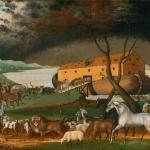A literal reading of the size of the ark in the Bible (incorporating differences in the length of a cubit) is 525-624 ft x 87.5-104 ft x 52.5-62.4 ft. But since the Sexagesimal numerical system was different in Babylonia in c. 2900 BC, these are likely larger figures than the ark actually was. See my related articles on biblical numbers: 969-Year-Old Methuselah (?) & Genesis Numbers (7-12-21), and Pearce’s Potshots #31: How Many Israelites in the Exodus? [5-27-21].
It’s also true that the Bible very often uses symbolic rather than literal numbers. Geologist Carol A. Hill (an evangelical Lutheran) explained this different system in her article, “Making Sense of the Numbers of Genesis” (Perspectives on Science and Christian Faith, Volume 55, Number 4, December 2003). She stated:
We find the same kind of symmetry and symbolism in other chapters of Genesis in the original Masoretic Hebrew text. Some examples that show the numerical “tightness” and regularity of the text are: in Gen. 2, Adam is mentioned 28 (7 x 4) times; in Gen. 4:15, . . .; the names listed in Cain’s family, counting from Adam to Naamah are 14 (7 x 2); and Cain’s name is mentioned 14 (7 x 2) times. In the story of Noah and the Flood in chapters 6–9, there is also a numerical symmetry and parallelism to the text. The number seven is used repeatedly; seven days (Gen. 7:4, 10; 8:10, 12), seven pairs of clean animals and birds (Gen. 7:2–3); the number of times that God spoke to Noah was exactly seven. Repetitions (such as the “waters prevailed and increased”; Gen. 7:17, 18, 19, 20, 24) are included for the sake of parallelism in accordance with the customary stylistic convention of the time. Noah’s age of 600 (60 x 10) was considered to be a perfect number in the sexagesimal system, and was symbolic of Noah’s perfection as a person (Gen. 6:9). The size of the ark was 300 (60 x 5) cubits by 50 (10 x 5) cubits by 30 (6 x 5) cubits—numbers that also probably should be taken symbolically (numerologically) rather than literally.
Atheists and other skeptics point out that a wooden boat as large as the ark would have been (if we interpret the numbers literally) could not possibly float for any length of time. The Wyoming was the largest wooden schooner ever built [see how long other wooden ships have actually been]. It was 329 feet between perpendiculars. Built in 1909, it sailed until 1924, when it sank. A Smithsonian Magazine article also noted:
[A]ccording to Euler-Bernoulli beam theory, the strength of a wooden beam decreases with its size, so because when things get bigger they break more easily, the beams that held this huge ark together might have been extremely fragile. Else the beams were short, which would also introduce structural weaknesses due to the higher number of seams between wood planks.
One of the commenters on a Reddit / askscience web page devoted to the question, “Why is there a limit to how big wooden boats can be?” explained:
Wood is not stiff enough. Wood bends in the wind, which is a great attribute for trees, but terrible news for boat-builders. Wood is not long enough. Due to the maximum height of trees, the maximum practical length of a single wooden beam is about say 80 metres.
. . . if you try to build a boat longer than 80 metres [262.47 feet], you will necessarily have seams between the beams both lengthwise and crosswise. When the boat is in the water and encounters waves, it will experience hogging and sagging forces. The wooden beams will bend, and the seams will open up, letting water in, and sinking the boat.
Perhaps for this reason, none of the three existing ark replicas (Grant Co., Kentucky: 510 feet long; Hong Kong: 450 feet; Dordrecht, Netherlands: 450 long) actually float on water (with or without a load of animals, and pitch to keep the water out). The last mentioned is (in a way) on the water, but it is upheld by 21 steel barges.
An article entitled, “The Impossible Voyage of Noah’s Ark” noted:
The largest wooden ships ever built were the six-masted schooners, nine of which were launched between 1900 and 1909. These ships were so long that they required diagonal iron strapping for support; they “snaked,” or visibly undulated, as they passed through the waves, they leaked so badly that they had to be pumped constantly, and they were only used on short coastal hauls because they were unsafe in deep water.
This is an altogether valid and serious criticism, and Bible students and apologists have to grapple with it. If we have a plausible explanation for a non-literal biblical reading of the ark’s actual dimensions (i.e., “literal” meaning our current numbering system), it seems that we should follow that course, since both experience and science strongly suggest the almost certain unseaworthiness of a 450-foot long (or longer) wooden boat, built in c. 2900 BC.
The 1915 International Standard Bible Encyclopedia (“Number”) goes into great detail about biblical numerology:
Numerical symbolism, that is, the use of numbers not merely, if at all, with their literal numerical value, or as round numbers, but with symbolic significance, sacred or otherwise, was widespread in the ancient East, especially in Babylonia and regions more or less influenced by Babylonian culture which, to a certain extent, included Canaan. It must also be remembered that the ancestors of the Israelites are said to have been of Babylonian origin and may therefore have transmitted to their descendants the germs at least of numerical symbolism as developed in Babylonia in the age of Hammurabi. Be that as it may, the presence of this use of numbers in the Bible, and that on a large scale, cannot reasonably be doubted, although some writers have gone too far in their speculations on the subject. The numbers which are unmistakably used with more or less symbolic meaning are 7 and its multiples, and 3, 4, 10 and 12. [my italics and bolding]
1. Seven and Its Multiples:
By far the most prominent of these is the number 7, which is referred to in one way or another in nearly 600 passages in the Bible, as well as in many passages in the Apocrypha and the Pseudepigrapha, and later Jewish literature. Of course the number has its usual numerical force in many of these places, but even there not seldom with a glance at its symbolic significance.
The article then goes into extreme depth, with copious biblical examples: especially about the number 7: to which it devotes the next fifteen paragraphs (many of them very long). Then it examines the biblical symbolic use of 3, 4, 5, 10, and 12.
Carol A. Hill, in her book, A Worldview Approach to Science and Scripture: Making Genesis Real (Grand Rapids, Michigan: Kregel Publications, 2019), incorporated this understanding into her interpretation of the dimensions of the ark:
Genesis 7:11, the beginning of the flood account, is a prime example of how a Bible verse can describe real historical events, yet at the same time contain the worldview of the ancient author(s). (p. 56).
Here is that passage in RSV:
In the six hundredth year of Noah’s life, in the second month, on the seventeenth day of the month, on that day all the fountains of the great deep burst forth, and the windows of the heavens were opened.
Dr. Hill continues:
[T]his was probably not his actual age, but a sacred, symbolic age — one of the most “perfect” numbers in the sexagesimal numbering system, according to the worldview of the Mesopotamians. . . . “second month, seventeenth day,” . . . was intended by the biblical author(s) to pinpoint the exact time of the year when the flood started. This date corresponds to the beginning of the actual rainy season in Mesopotamia (middle March) because it records a real historical memory. (p. 56)
In other words, there was likely a mixture of symbolism (Noah’s age) and literalism (the date when the Flood began). Since we can verify the second thing by weather patterns in Iraq today, we have reason to believe that it was intended literally. And we also know about symbolic use of numbers in the Bible. Dr. Hill then analyzes how this use of sacred, symbolic numbers applies to the size of the ark and the duration of the Flood and other aspects concerning it:
The size of the ark is said to have been 300 cubits long, 50 cubits wide, and 30 cubits high (Gen. 6:15). These are also probably figurative numbers rather than real numbers. Three hundred is exactly half of the sacred number 600, and 30 is one-tenth of 300. Three hundred divided by six (6, a bi-sexagesimal number) is 50, or the width of the ark. Genesis 7:34 says that the flood water prevailed upon the earth for 150 days, or one-half of 300. The ark rested in the seventh month (the preferred number 7) on the seventeenth day (10 + 7, two preferred numbers) of the month . . . (Gen. 8:4). . . .
All of this is not a numerically accurate account of a real flood event, but it is a numerologically sacred account of what could have been a record of a very large historical flood. In other words, the literal meaning of the account is what was literal from the religious point of view of the biblical authors, not what would be considered literal today. Thus, a perfectly “literal” interpretation of the Genesis flood story combines a probable historical event with the worldview of the biblical author(s), and one must filter out the worldview aspects to get to the historical core of the text. If this is not done, the numbers make the text seem mythological and at odds with science and reason (our reasoning, not theirs). (p. 56)
Catholic writer Ron Conte concurs:
The Bible does not present the dimensions of the Ark as necessarily literal or historical. The existence of Noah and the event of the Flood are presented as literal and historical, but not all the details of the Flood. In addition, since the numbers assigned to the ages of Noah and his ancestors and some of his descendants are figurative, the numbers assigned to the size of the Ark may also be figurative: 300 x 50 x 30 cubits. . . .
[T]hese numbers may indicate, on the direct level, the correct proportions of the ship, the length being six times the width and ten times the height. The low height would give the Ark a low center of gravity. The length would give the Ark stability in waves. . . .
Many commentators have rightly pointed out that it would be very unlikely that Noah could have built such a ship, if the dimensions given in the Bible are literal (assuming a cubit of approximately 18 inches). They therefore jump to the unwarranted conclusion that no such ship was built at all. But a combined literal and figurative approach to the passage would suggest that the size of the ship is a figure, and yet Noah did literally build the ship. (“What Size Was Noah’s Ark?”, The Reproach of Christ, 3-2-14)
Now, it’s true that in my defense of a local Flood I assumed that the numbers for duration were literal. (and Dr. Hill assumes that the biblical statement as to the beginning date of the Flood was indeed literal, based on our knowledge of Iraqi meteorology). I think it worked (scientifically) using those numbers. But if they were intended to be figurative and smaller than the literal numbers, then the case would be all the easier to make.
***
Practical Matters: Perhaps some of my 4,000+ free online articles (the most comprehensive “one-stop” Catholic apologetics site) or fifty books have helped you (by God’s grace) to decide to become Catholic or to return to the Church, or better understand some doctrines and why we believe them.
Or you may believe my work is worthy to support for the purpose of apologetics and evangelism in general. If so, please seriously consider a much-needed financial contribution. I’m always in need of more funds: especially monthly support. “The laborer is worthy of his wages” (1 Tim 5:18, NKJV). 1 December 2021 was my 20th anniversary as a full-time Catholic apologist, and February 2022 marked the 25th anniversary of my blog.
PayPal donations are the easiest: just send to my email address: [email protected]. You’ll see the term “Catholic Used Book Service”, which is my old side-business. To learn about the different methods of contributing, including 100% tax deduction, etc., see my page: About Catholic Apologist Dave Armstrong / Donation Information. Thanks a million from the bottom of my heart!
***
Photo credit: [public domain / Piqsels]
***
Summary: I contend that the ark & the Flood were historical events, but that the size of Noah’s ark in the Bible is symbolic, based on massive biblical numerological symbolism.














